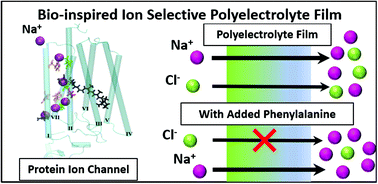Bio-inspired incorporation of phenylalanine enhances ionic selectivity in layer-by-layer deposited polyelectrolyte films†
Abstract
The addition of a common amino acid, phenylalanine, to a Layer-by-Layer (LbL) deposited polyelectrolyte (PE) film on a nanoporous membrane can increase its ionic selectivity over a PE film without the added amino acid. The addition of phenylalanine is inspired by detailed knowledge of the structure of the channelrhodopsins family of protein ion channels, where phenylalanine plays an instrumental role in facilitating sodium ion transport. The normally deposited and crosslinked PE films increase the cationic selectivity of a support membrane in a controllable manner where higher selectivity is achieved with thicker PE coatings, which in turn also increases the ionic resistance of the membrane. The increased ionic selectivity is desired while the increased resistance is not. We show that through incorporation of phenylalanine during the LbL deposition process, in solutions of NaCl with concentrations ranging from 0.1 to 100 mM, the ionic selectivity can be increased independently of the membrane resistance. Specifically, the addition is shown to increase the cationic transference of the PE films from 81.4% to 86.4%, an increase on par with PE films that are nearly triple the thickness while exhibiting much lower resistance compared to the thicker coatings, where the phenylalanine incorporated PE films display an area specific resistance of 1.81 Ω cm2 in 100 mM NaCl while much thicker PE membranes show a higher resistance of 2.75 Ω cm2 in the same 100 mM NaCl solution.



 Please wait while we load your content...
Please wait while we load your content...